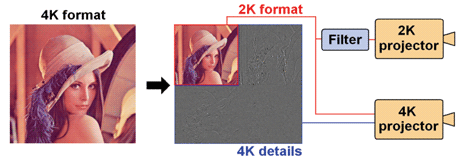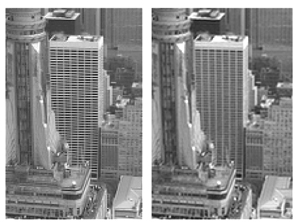In 2002, seven of the biggest Hollywood studios created the DCI (Digital Cinema Initiative), aimed at producing the first digital cinema specifications. This official document describes the technological issues that must be respected by the various processes and material and security protocols in order to be compliant with Hollywood's prerequisites on the quality of content playback and security throughout the distribution and projection chain.
The DCI specifies that films must be compressed using JPEG 2000 with a maximum bit-rate of 250Mbps. It allows two different formats for digital movies: the 2K format, with a resolution of 2048 x 1080 pixels and the 4K format, with a resolution of 4096 x 2160 pixels. Despite the fact that 4K improves the visual quality, the cost of the necessary equipment means that most cinemas have currently chosen to install 2K projectors. This kind of choice has a historical precedent in 35mm and 70mm film formats.

While the coexistence of 35mm and 70mm formats required the creation of reels for both, JPEG 2000 enables studios to encode a single 4K version of the movie. With JPEG 2000 scalability, the 2K version can easily be extracted from the 4K version. This feature comes from the compression algorithm itself. The first step of any compression algorithm is to reduce the redundancy in the image. The wavelets used in JPEG 2000 have proven to be highly efficient in doing this through a multi-resolution decomposition of the image. This decomposition splits the original image (4K) into four sub-bands, one containing the lower resolution (2K) and the others containing the details necessary to reconstruct the original image (see Figure 1). The process is repeated on the lower-resolution sub-band several times, and each sub-band is then encoded separately with an entropy coder. Prior to the projection, the decoding process can discard the sub-bands of 4K details to produce 2K images.
In the context of EDCine, a European project intending to bring digital cinema standards to Europe, the UCL (Université catholique de Louvain) is currently studying ways of making the most of JPEG 2000 scalability for digital cinema. We have raised two issues related to the way this scalability is exploited, and showed that the interoperability between 2K and 4K formats can be improved.
The first issue concerns the bit-rate limitation. Under such constraints, the information to be included in the 250Mbps must be selected in order to maximize the visual quality of the compressed image. This process is called the rate allocation. When a 4K image is encoded, the quality is usually optimized for 4K theatres, without taking into account the 2K theatre experience. Our research has shown that we can significantly improve the 2K quality without noticeably deteriorating the 4K quality, by taking both 2K and 4K user experiences into account during the rate allocation process.

Thanks to JPEG 2000 scalability, the complexity of the proposed solution is four times lower than a standard downsampling from 4K to 2K.
Link:
EDCine project: http://www.edcine.org
Please contact:
Pascal Pellegrin, François-Olivier Devaux, Pedro Correa Hernandez
Université catholique de Louvain, Belgium
Tel: +32 1023 8484
E-mail: pellegrin![]() tele.ucl.ac.be, francois.devaux
tele.ucl.ac.be, francois.devaux![]() uclouvain.be,
uclouvain.be,
pedro.correa![]() uclouvain.be
uclouvain.be










